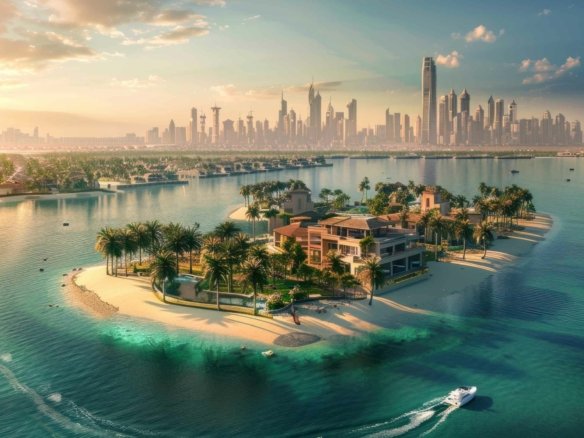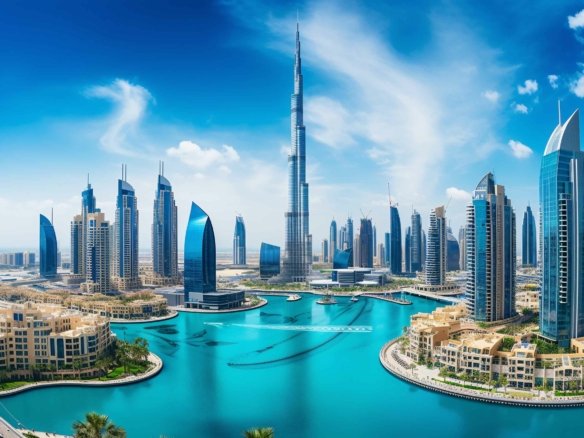Dubai’s transformation into a global metropolis is deeply reflected in its skyline, which has become synonymous with innovation, ambition, and cultural fusion. From its modest beginnings as a small fishing village to becoming one of the most futuristic cities in the world, Dubai’s architectural journey tells a fascinating story of vision and determination. In this blog, we explore the history and significance of some of Dubai’s most iconic buildings, delving into how they came to define the city as a global hub for tourism, business, and culture.
1. Burj Khalifa: The Pinnacle of Human Ingenuity
- Completion Date: 2010
- Architect: Adrian Smith (Skidmore, Owings & Merrill)
- Height: 828 meters
The Burj Khalifa is a defining landmark of Dubai and the tallest building in the world. Its construction began in 2004 as part of the Downtown Dubai project. Designed to resemble a desert flower, the building combines Islamic architectural principles with cutting-edge engineering. Its spire reaches an incredible 828 meters, breaking multiple world records. The Burj Khalifa features luxury apartments, office spaces, and the Armani Hotel. The observation decks, such as At the Top, offer panoramic views of Dubai, drawing millions of visitors annually. The structure is also an environmental marvel, using advanced systems to minimize energy consumption and optimize cooling in the hot desert climate.
2. Burj Al Arab: The Symbol of Luxury
- Completion Date: 1999
- Architect: Tom Wright
- Height: 321 meters
The Burj Al Arab, often described as the most luxurious hotel in the world, stands on an artificial island connected to the mainland by a private bridge. Its sail-shaped design pays homage to Dubai’s maritime heritage. The construction took five years, with a focus on creating a world-class hospitality experience. The interiors are lavish, featuring 24-carat gold accents and extravagant suites. The hotel also boasts unique attractions, such as an underwater restaurant (Al Mahara) and a helipad that has hosted events like tennis matches and auto stunts. The Burj Al Arab represents Dubai’s commitment to redefining luxury tourism.
3. Palm Jumeirah: The Eighth Wonder of the World
- Completion Date: 2006 (initial phase)
- Developer: Nakheel Properties
Palm Jumeirah, a man-made archipelago shaped like a palm tree, is an engineering marvel that put Dubai on the map as a global luxury destination. Its construction required an estimated 120 million cubic meters of sand and seven million tons of rock, with meticulous attention to detail. Palm Jumeirah offers luxury villas, five-star hotels, and high-end restaurants. Iconic properties like Atlantis, The Palm, and The Pointe entertainment district make it a hotspot for both tourists and investors. The development showcases Dubai’s ability to create innovative infrastructure while expanding its coastline.
4. Dubai Frame: Bridging the Past and Future
- Completion Date: 2018
- Architect: Fernando Donis
The Dubai Frame is a unique architectural masterpiece located in Zabeel Park. Designed to resemble a picture frame, the structure symbolizes the city’s journey from its historical roots to its modern aspirations. The Frame stands 150 meters tall and 93 meters wide. Visitors can view old Dubai, including the Al Fahidi Historical Neighbourhood, from one side, and the futuristic skyline, including the Burj Khalifa, from the other. The Frame is a literal and metaphorical window into Dubai’s dynamic evolution.
5. Museum of the Future: An Architectural Marvel
- Completion Date: 2022
- Architect: Shaun Killa
The Museum of the Future is an ultra-modern structure designed to explore advancements in technology, sustainability, and innovation. Its elliptical shape, adorned with Arabic calligraphy, is both visually stunning and symbolically significant. The museum aims to challenge traditional norms by providing immersive experiences in artificial intelligence, robotics, and climate solutions. Its mission is to inspire and prepare humanity for future challenges, positioning Dubai as a global leader in innovation.
6. Atlantis, The Palm: A Gateway to Extravagance
- Completion Date: 2008
- Developer: Kerzner International
Atlantis, The Palm, is a luxury resort that occupies a prime location on Palm Jumeirah. Its design is inspired by the mythical city of Atlantis, featuring marine-themed architecture and attractions. The resort is famous for its Aqua venture Waterpark, the Lost Chambers Aquarium, and celebrity-chef restaurants. Atlantis redefined Dubai’s hospitality landscape, attracting families, celebrities, and luxury seekers from around the world.
7. Cayan Tower: A Twisted Wonder
- Completion Date: 2013
- Architect: Skidmore, Owings & Merrill
Cayan Tower, located in Dubai Marina, is the world’s tallest twisted tower, with a 90-degree spiral that defies conventional design principles. Its construction required cutting-edge engineering to ensure stability and functionality. The twisting design reduces wind pressure and allows for unobstructed views of the marina and Arabian Gulf. The tower is primarily residential, offering luxurious apartments that epitomize modern urban living.
8. Dubai Opera: A Cultural Icon
- Completion Date: 2016
- Architect: Janus Rostock
The Dubai Opera is a dhow-shaped building located in the heart of Downtown Dubai. It serves as a multi-functional venue for opera, ballet, theater, and concerts. The building is a testament to Dubai’s commitment to cultural and artistic growth, attracting global performers and events. Its flexible design allows it to transform into a banquet hall, exhibition space, or concert venue, making it a hub for creativity and innovation.
9. Jumeirah Emirates Towers: Business Meets Style
- Completion Date: 2000
- Architect: Hazel Wong
The Jumeirah Emirates Towers are twin skyscrapers that have become a symbol of Dubai’s rise as a global business hub. Their sleek triangular design combines elegance with functionality, housing offices and a luxury hotel. The towers are strategically located near the Dubai International Financial Centre (DIFC), reflecting Dubai’s reputation as a world-class business destination.
10. Al Fahidi Historical Neighbourhood: Preserving the Past
- Established: Late 19th century
Al Fahidi Historical Neighbourhood, also known as Bastakiya, offers a glimpse into Dubai’s past. The area is characterized by narrow lanes, wind-tower houses, and traditional courtyards. It serves as a cultural hub, housing museums, art galleries, and traditional cafes. Al Fahidi stands in stark contrast to Dubai’s modern skyline, reminding visitors of the city’s humble beginnings.





Join The Discussion